Love herbs? Me too! They grow well in containers so you can grow them anywhere! But if you want them to come back year after year, here is how to grow perennial herbs in a container using the right soil, plants, and growing conditions. Plus, you’ll learn which herbs to plant for the best results.
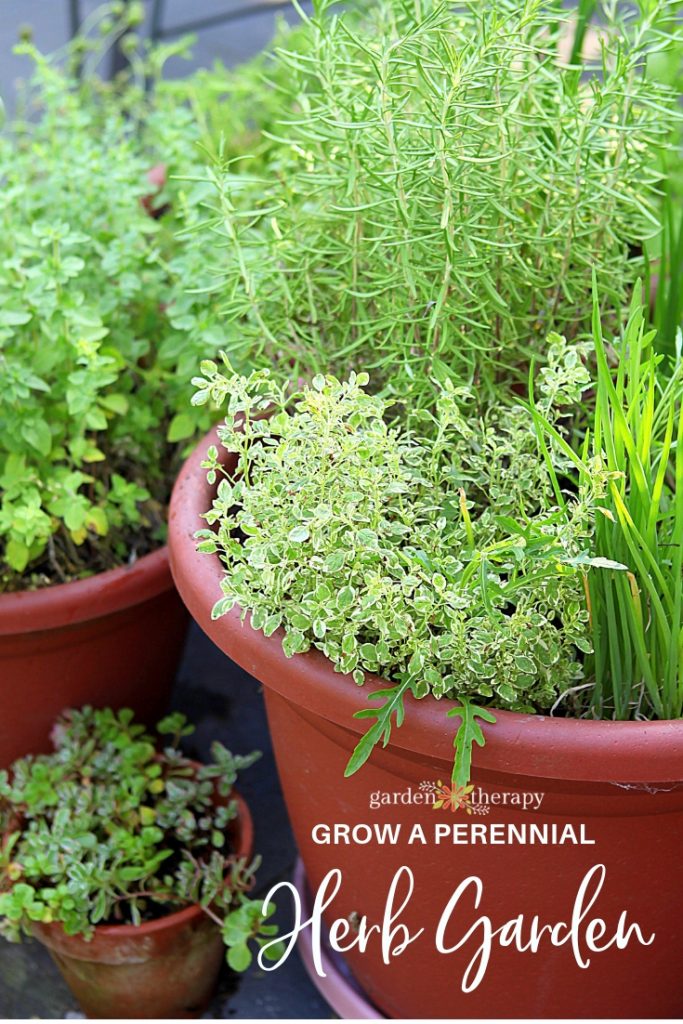
For years now I have been growing herbs in containers just down the deck stairs from the kitchen. While a few changes are made each year, the foundation of this garden is perennial herbs.
The garden will continue to produce for much of the year, allowing me winter harvests of sage, marjoram, rosemary, oregano, and sometimes arugula. Other herbs will pop up in their due time from chives in early spring to saffron crocuses in the fall.
Nothing satisfies the tastebuds and the cooking soul quite like fresh herbs. Plant a herb garden and you may never need to rely on the grocery store for dried herbs every again!
This post will cover…
- Container Herb Garden Layout
- Growing a Perennial Herbs in a Container Garden
- Pick Your Pot
- Use Good Soil
- Site Selection
- What Kind of Herbs Can I Grow Outside in Pots?
- Mint, Lemon Balm, and Oregano
- Rosemary
- Egyptian Walking Onions
- Chives
- Tarragon (French)
- Salad Burnet
- Thyme
- Arugula
- More on Growing Perennial Herbs
- Frequently Asked Questions About Perennial Herbs in Containers
- More About Herbs
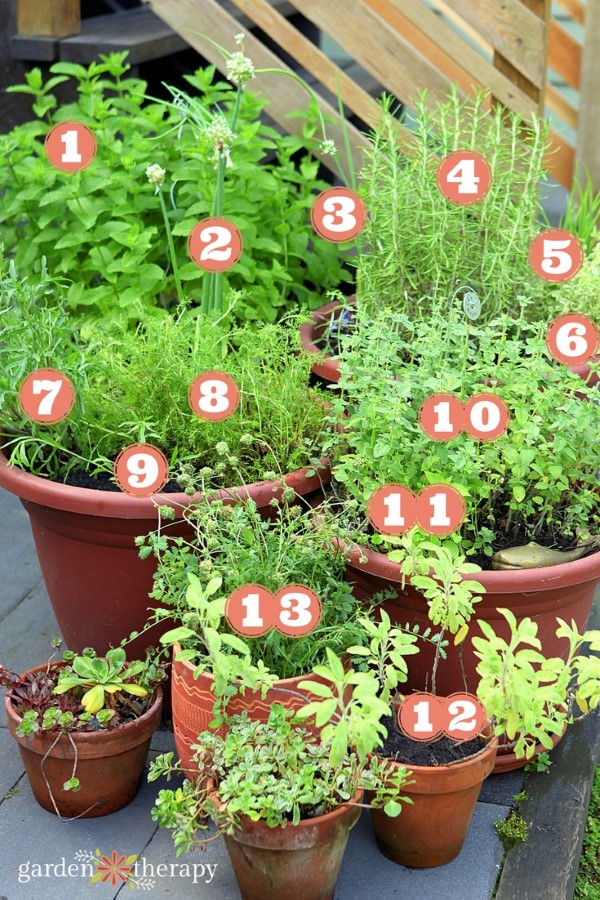
Container Herb Garden Layout
This perennial herb container garden has 13 different herbs growing that come back year after year. The numbers on the photo above correspond to the herbs in this list:
- Mojito Mint
- Egyptian Walking Onions
- Saffron
- Rosemary
- Chives
- Marjoram
- Arugula
- Chamomile
- Tarragon
- Oregano (Hot n’ Spicy)
- Anise Hyssop
- Sage
- Salad Burnet
Add in some annuals like basil, parsley, and cilantro and you have yourself everything you need for your kitchen.

Growing a Perennial Herbs in a Container Garden
Let’s chat about how to actually get started growing your herbs in a container garden. Here’s what you need to consider:
Pick Your Pot
In most cases, larger is better if you plan to over-winter your herb garden container. Pots that are 16”-20” in diameter will allow your herbs to grow into fairly large plants while you continue to harvest them.
For over-wintering, choose plastic pots. You can dress up the area with some smaller terracotta or other decorative pots, but plastic is weather safe and will help protect the roots through the cold.
Use Good Soil
Starting with high-quality potting soil gives your herb garden container the best start. Each year it’s a good idea to scratch in some good compost and replace the soil completely after a few years. Regular feeding throughout the gardening season will encourage healthy growth and strong production.
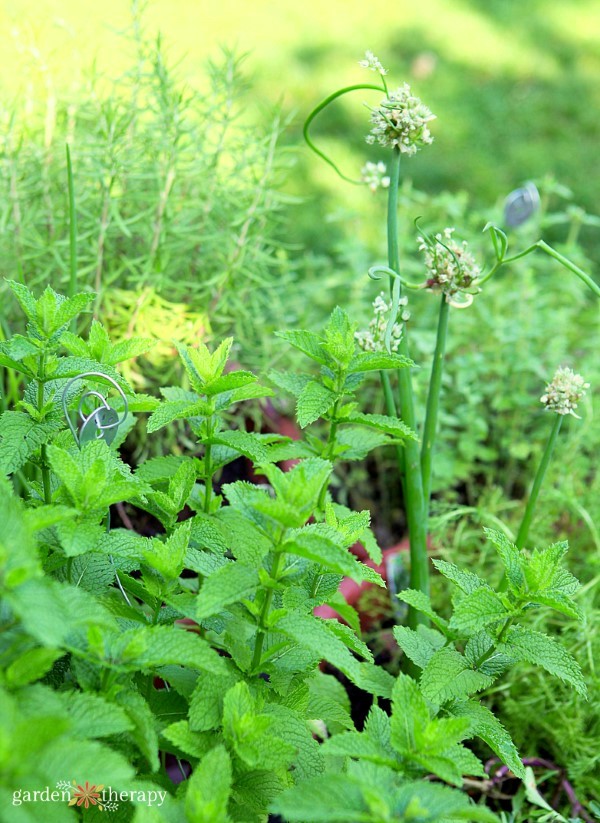
Site Selection
The best site for your herb garden container is near the kitchen. You aren’t going to love traipsing around in the rain to find herbs at the back of your property. Knowing that your kitchen garden is close by will encourage you to snip away when your meal needs a little extra va-va-voom.
Some herbs like it sunny, hot, and dry, while others prefer a cooler, shadier location. When you choose your plants think of where you are going to place your herb garden container and select accordingly.
What Kind of Herbs Can I Grow Outside in Pots?
There are just so many perennial herbs out there, so the best place to start is to decide what you love and will use. Next, check out your local nursery or ask neighbours to find ideas that just may inspire a new favourite.
Here is some information on just a few of the perennial herbs you can grow in your garden.

Mint, Lemon Balm, and Oregano
Mint is a fast-growing and spreading herb that, while wonderful for teas, cooking and cocktails, can quickly take over the garden. For this reason, mint is best grown in containers. The same is true for lemon balm and oregano. Grow these three in large containers and you’ll always have enough.
Rosemary
In milder areas, rosemary will overwinter but in cooler climates, you should bring plants in for the cold season.
Egyptian Walking Onions
These are fun alliums that have a mild garlic flavour. They set bulbs up at the top of the plant which becomes heavy, flops over, and plants itself in the ground, AKA ‘walking.’
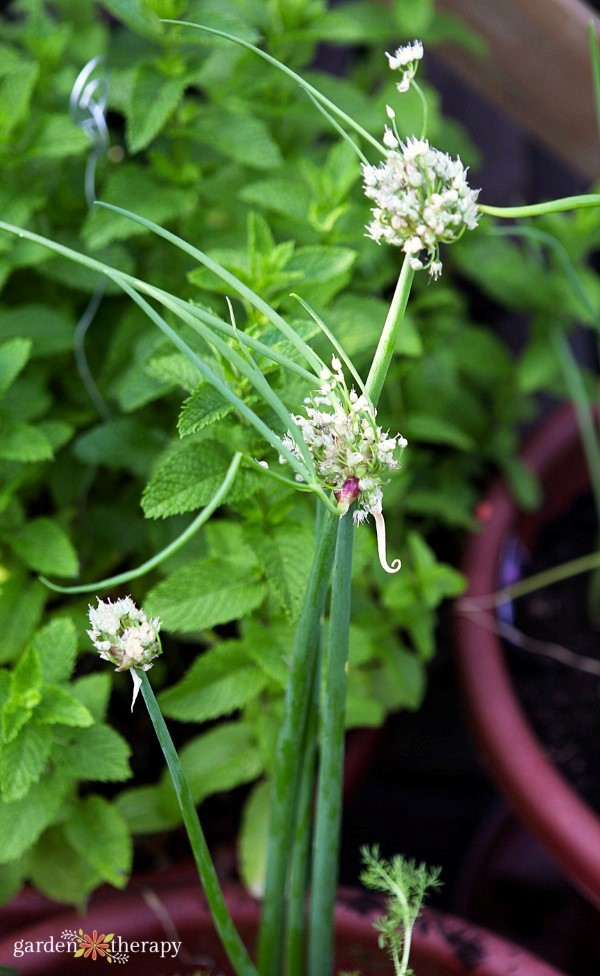
Chives
Chives are so prolific that you’d be hard-pressed to find a gardener nearby who won’t give you a chunk to plant. The pretty purple flowers freeze well and will add a mild onion flavour to soups and dressings. Chive-flower vinegar, anyone?
Tarragon (French)
A sweeter herb with more of an anise flavour that tastes great on chicken or, again, in vinegar. Don’t be fooled by packets of seeds sold as Russian tarragon, it doesn’t stand up in flavour to the French.
Salad Burnet
With a light cucumber flavour, salad burnet is great in (you guessed it!) salads. Leaves can be added to the bowl or used to make a flavoured vinegar or dressing.
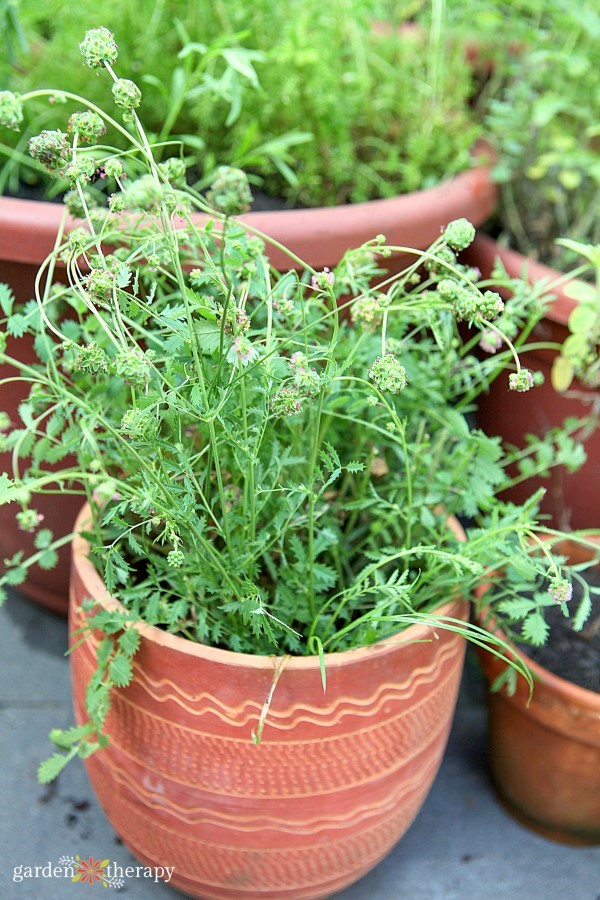
Thyme
A wonderful culinary herb for most, but I don’t like the taste. I do love the creeping versions of thyme growing in between pavers though. Check out great cultivars like lemon thyme and woolly thyme, which are exactly what you would expect them to be from their names.
Arugula
Wild arugula has a peppery flavour and hardy temperament. Given enough depth for the long taproot, arugula will produce a small shrub of leafy greens to add to salads and sandwiches.
Chamomile
This beautiful herb has just the most heavenly scent. Dry chamomile flowers for a sleepy-time tea or use them in natural bath products (like this Cold-Process All-Natural Handmade Soap).
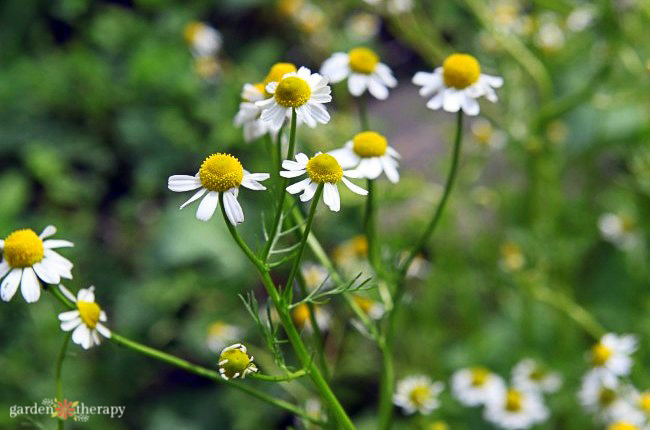
Saffron
This expensive herb comes from the bright orange stigmas in the center of the saffron crocus. Pluck the stigmas off frugally, as each flower only produces three of them. This explains why saffron is so darn expensive. You may not be able to grow more than you will use in one recipe, but that’ll be one delicious paella.
Bay
Those large leaves used in soups and stews come from the bay laurel, which is typically trained into a large tree that is as slow-growing as it is beautiful. If you have a friend with one or a spot in the garden, you will never run out of dried bay leaves as a mere few adds a lot of flavour.
Lavender
I can’t say enough good things about lavender. I have many lavender plants in my garden so I can make things like Lavender Eye Pillows, Lavender Bath Salts, Gardener’s Herbal Foot Soak Recipe, Lavender Sachets, and a Dried Lavender Wreath.
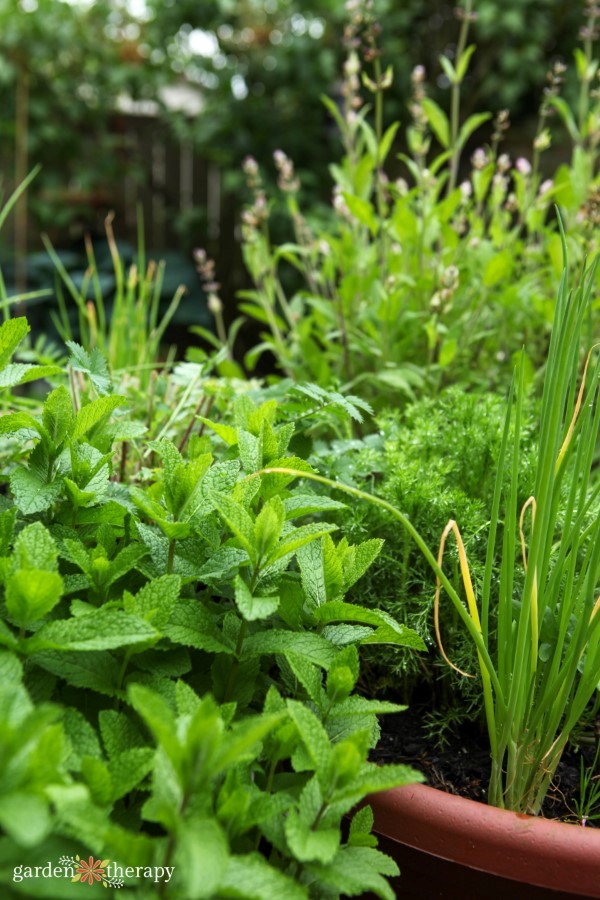
More on Growing Perennial Herbs
Now, this is only a small fraction of what can be said about growing herbs in containers. For a more extensive list of herbs plus more information on planning, growing and using herbs, check out Your Backyard Herb Garden: A Gardener’s Guide to Growing Over 50 Herbs Plus How to Use Them in Cooking, Crafts, Companion Planting and More. It’s an excellent resource for all things herbs with a detailed directory covering 52 herbs in detail and it even has some great recipes! I love this book.
Also, be sure to check out this DIY project on making Metal-Stamped Plant Tags from Hardware Store Finds so you can label up your new herb garden container.
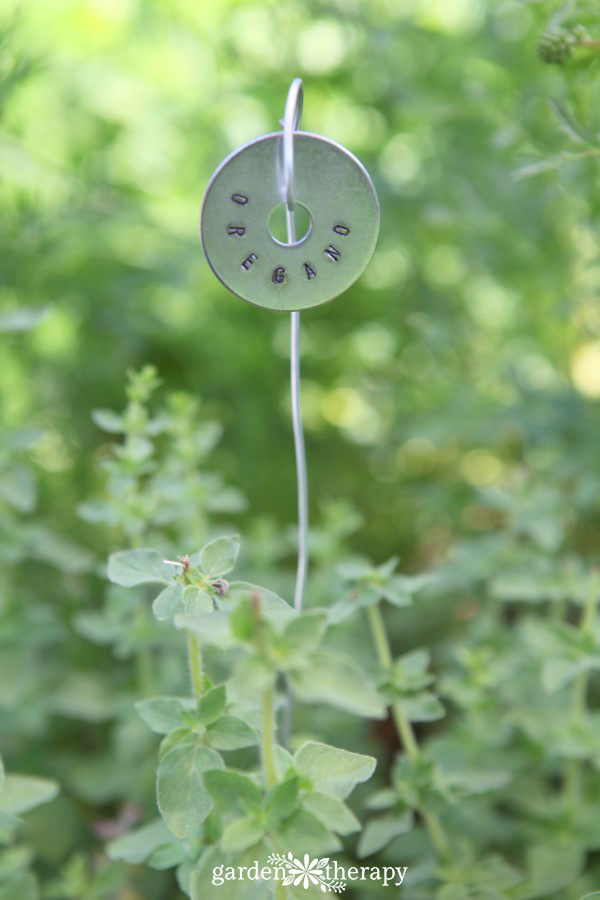
Frequently Asked Questions About Perennial Herbs in Containers
Not all herbs will make it through the winter. For quick reference, some of my favourite perennial herbs include mint, lemon balm, oregano, rosemary, Egyptian walking onions, chives, tarragon, burnet thyme, arugula, chamomile, saffron, bay, lavender, arugula, anise hyssop, sage, and marjoram.
You can use pots for individual plants as small as 10 inches in diameter which are about 3 inches tall.
For an herb container garden, a bigger pot can house multiple herbs. Choose one that is 16 to 20 inches in diameter which is about 14 to 18 inches deep.
Generally, you can group together herbs in a container that like the same environment (light, soil, and water). For instance, group together Mediterranean herbs like lavender, rosemary, thyme, sage, marjoram, and oregano.
Fennel has been known to stunt the growth of surrounding plants and should be kept separate from other plants.
Keep sage away from dill, basil, rye, and any onions. Instead, plant it with thyme, marjoram, and rosemary.
Plants such as mint, lemon balm, and oregano can grow quickly and get invasive, so they might be best left to grow in a container on their own.
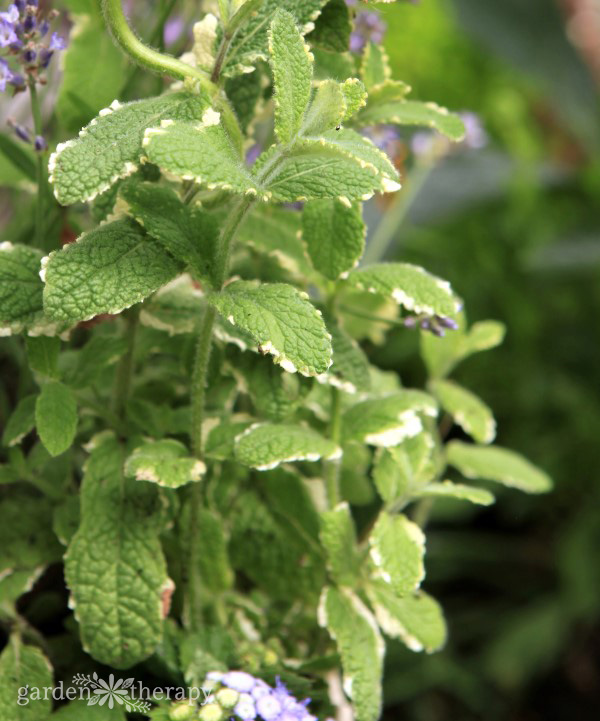
That’s it on perennial herbs! I talked about my favourites now let me know in the comments down below which herbs you like to grow in containers.

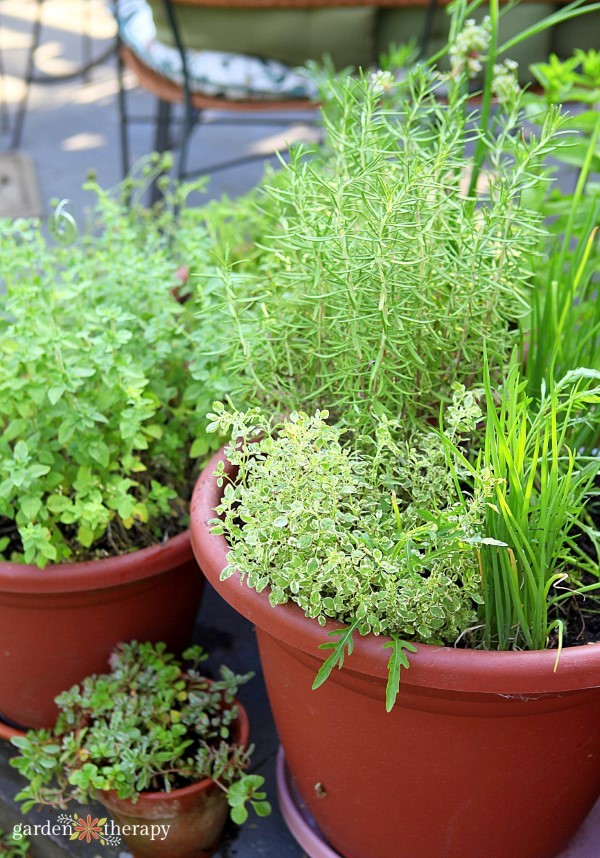



Superb kind of work by the team as on this particular topic people needs more precise information and special attention to it.Thanks a lot.
Your pots look gorgeous. I am trying to reclaim some precious raised bed garden space by transplanting my periennial herbs into pots. Yours look so tidy. How do you keep them from getting overgrown? Do you cut way back in the fall/spring? I’d appreciate any advice!
Hi Laura, I cut most of them back in the spring, except the oregano and rosemary which I shape in the summer. In the fall I let the it go wild! The plants flower and set seeds and it feeds the birds and bees for me. Thanks so much for your comment!
Thank you for the prompt reply! Do you think that I could divide my overgrown perennial herbs now (fall, zone 6) and pot them in some decent sized plastic pots for the winter? I really appreciate the help . . .
Sure, I mean if you think they will survive winter OK and you won’t be too sad if you lose a few. I would do it here in zone 7b, but make sure that I had them in large plastic pots with plenty of soil.
The idea of large containers for a perennial herb garden is wonderful and yours is beautiful, but here in Zone 4-4A the pots could not be left out in winter for the herbs to winter over — the mint and chives would winter in the ground I know, but others would not survive (there is a lavender that winters) – what would you suggest for the large pots with the herbs in them? I really would like to try this…
Hi Kerri, how about plastic pots? Or insulated fiber pots? Your local nursery may have some options that will over winter. Also, with my more tender plants I move them under cover in the winter, just near the garage under the overhang. It works like a charm!
I would like to know where to find all these herbs at this time of year. I am new to this . My 1st time growing in containers. I did 2 kinds of tomatoes and peppers , string beans.etc. I also did green onions which the wild life likes cause i didn’t get1.Lol . Shellly1966@yahoo